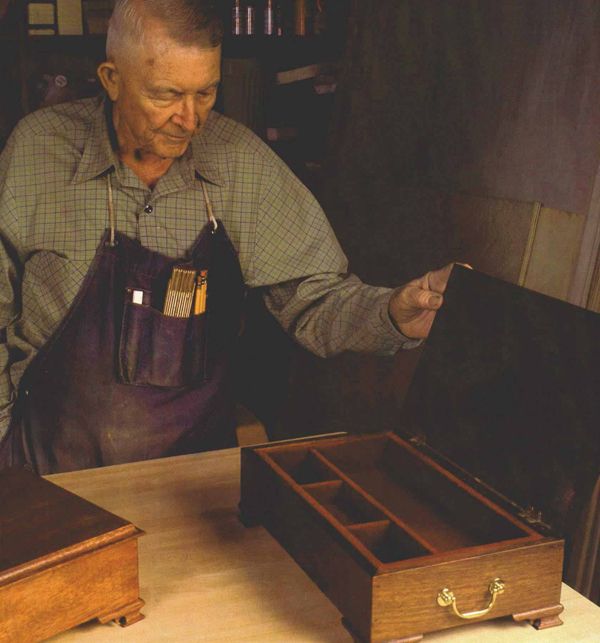Making Ogee Bracket Feet
Templates and jigs make neat feet for a box
Synopsis: Small ogee bracket feet elevate a plain jewelry box both figuratively and literally, writes Sam Fletcher. His method of making them uses a standard cove cutter and basic hand and machine tools, and it can make miniature or larger sized feet as needed. He makes a template and a glue jig first and then makes the ogee profile. He explains how he rips the stock to width and miters it and how he lays out and cuts the scroll. Multiple photos illustrate his technique, including tips such as using a dowel to hold the template in the blank.
I made a stack of Chippendale-style mirrors for our annual church sale, and I was disappointed when they didn’t sell as well as I’d hoped. When the next sale rolled around, I looked for a more successful project. I had read that small jewelry boxes are very popular at craft sales, so I decided to make them my next project for our fund-raiser.
Boxes are simple, and they are easily made, even in quantity. But they can be awfully plain. I wanted to dress them up a bit. I liked the effect that feet add to the overall look of a jewelry box. Small ogee bracket feet elevate a box both figuratively and literally.
High-volume shops use custom tooling to make ogee bracket feet, but my method uses a standard cove (or flute) cutter and basic hand and machine tools. Although I developed this method to make miniature feet, the general procedure can be used for making larger feet as well.
Make a template and glue jig first
Decorative scrolls on the wings of these miniature feet give them a distinctive Chippendale look. To speed the layout of this scroll, I made a template from plastic laminate and a small piece of -in. dowel. The dowel registers the template in each foot blank, saving me the trouble of locating the profile each time. The template also makes the feet consistent.
It can be tricky to glue small mitered pieces, so the simple jigs I make from 2-in.-sq., 1-in.- thick oak pieces are a great help. I bore a -in. hole in the center of each square and cut a 90° angle out of one side. The hole permits the pieces to fit together properly and takes care of glue squeeze-out. I use a 3-in, spring clamp and a short length of -in. dowel to hold the pieces together.
Making the ogee profile
I use a board 6 in. to 8 in. wide, surfaced to 1 in, thick, for a l-in.-high foot. The stock thickness corresponds to the height of the foot. To make feet for a box like the ones shown in the photo on the facing page, I use a board about 2 ft. long.
Using a wider board is faster because I can work on two edges at once, ripping them as I go. Having the extra width also makes machining the wood less dangerous.
I start by making the S-shaped ogee profile in the edge of the stock. The ogee can be very dramatic or subtle depending on how deeply I cut the groove and the size of the radius on the top edge.
From Fine Woodworking #119
For the full article, download the PDF below:
Fine Woodworking Recommended Products

Estwing Dead-Blow Mallet

Starrett 12-in. combination square

Dubuque Clamp Works Bar Clamps - 4 pack




















Log in or create an account to post a comment.
Sign up Log in